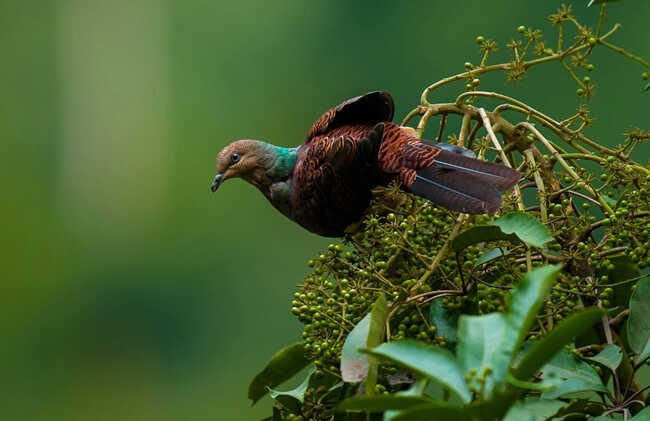Barred Cuckoo-dove
IUCN
LCBasic Information
Scientific classification
- name:Barred Cuckoo-dove
- Scientific Name:Pied coffee chase,Macropygia unchall,Barred Cuckoo-dove
- Outline:Landfowl
- Family:Dovetail D.family C.Dovetail
Vital signs
- length:32.4-41cm
- Weight:160-230g
- lifetime:No textual research information is available
Feature
A large, long-tailed turtle with black or brown markings on its back and tail
Distribution and Habitat
China is distributed in South China, north to Baoxing Sichuan and northwest Fujian, west to Yunnan, south to Hainan Island.
It inhabits mountain forests, but also occurs in the cultivated land and farmland in the low hills and the plain at the foot of the mountains in winter.
Appearance
The color of the pigeon body is different from the green or gray of other pigeon species. The forehead, eyes, cheeks, chin and throat skin of the male bird are yellow, slightly stained with purple, and the top of the head, back neck and side of the neck are greenish-purple and metallic. The rest of the upper body, including the upper wing small cover feathers, the middle cover feathers and a few inner feathers dark brown, densely brown-maroon fine stripes. The remaining wing coverts and flight feathers are dark brown. The central tail feathers are of the same color as the back, also dark brown with brownish maroon stripes, and the outer tail feathers are dark gray with black secondary tip spots. Upper chest red copper, with green luster, lower chest lighter. The belly is brown and white, and the undertail is brown.
The female is similar to the male, but the upper body is less shiny, and the head and thorax are black-brown fine stripes. The tail feathers are longer than those of pige
Details
Barred Cuckoo-dove has three subspecies.

Cuckoo doves are resident birds, partially wandering. Usually in pairs, occasionally alone, rarely in groups. Land with your tail up. Action is calm, not afraid of people, do not fly away immediately after seeing people, always stay and look at each other for a moment before taking off. It was a low, "coo-um-coo-um" sound. It mainly eats banyan fruit and other plant berries, seeds, grass seeds, and sometimes eats rice and other crops.
The breeding period is from May to August. They nest in pairs in dense forests and sometimes in bamboo groves, usually on branches or bamboo branches. The nest is very simple, mainly made of dead branches and grass. Each clutch lays 1 eggs, occasionally 2 eggs. The size of the egg is 30-38 mm x 20-28 mm.
During the incubation period, pigeon milk is secreted under the action of prolactin (also known as prolactin) secreted by the posterior pituitary gland. Pigeon milk is composed of fat particles, emulsified chylous fluid and lymph fluid exfoliated from the swollen flat epithelium in the lymphatic area of the bilateral side sac of female and male pigeons, that is, the crop bed lymph area. After colostrum stage, chylous fluid rich in emulsified fat particles is gradually added. In general, on the 4th to 5th day of incubation, the male and female pigeons' crop beds began to sprouted, and the blood vessels of the crop beds were congested, thickened, and lymphatic vessels hyperplasia. On the 8th to 9th day, the crop epithelium thickened and entered the pre-brooding state. On the 13th day, the thickness and width of the pigeon had doubled, transparent yellowish milk could be secreted on the 14th to 16th day, the crop could secrete the throat milk on the 18th day, but on the 7th day after the squabs emerged from the shell, the secretion of the crop milk began to decrease, and on the 10th day, the secretion stopped, and the squabs continued to retching until about 2 weeks of age, the crop bed began to shrink, and the milk secretion gradually ceased. The chymous pulp is gradually mixed into the semi-finished chymous pulp which is backflowed from the glandular stomach and ground through the muscle stomach, and then it is changed into the granule feed which is directly fed with water. If the hatched eggs fail to shell on time, the broody pigeons can continue to hatch until the 22nd to 24th day at most (these are related to the broody nature of the pigeons, the incubation season and the feedback of embryonic development information, the frequency of breaking the shell of the chicks, etc., such as in the cold winter and spring and the brooding period, the incubation period is often automatically extended, and it is often difficult to adhere to in the hot and hot days). At this time, the brood will automatically stop brooding with the shrinkage of the crop bed.
Listed on the International Union for Conservation of Nature (IUCN) 2013 Red List of Threatened Species ver3.1 - Not Threatened (LC).
It is listed in the second level of the List of China's National Key Protected Wildlife.
Protect wild animals and eliminate wild meat.
Maintaining ecological balance is everyone's responsibility!








